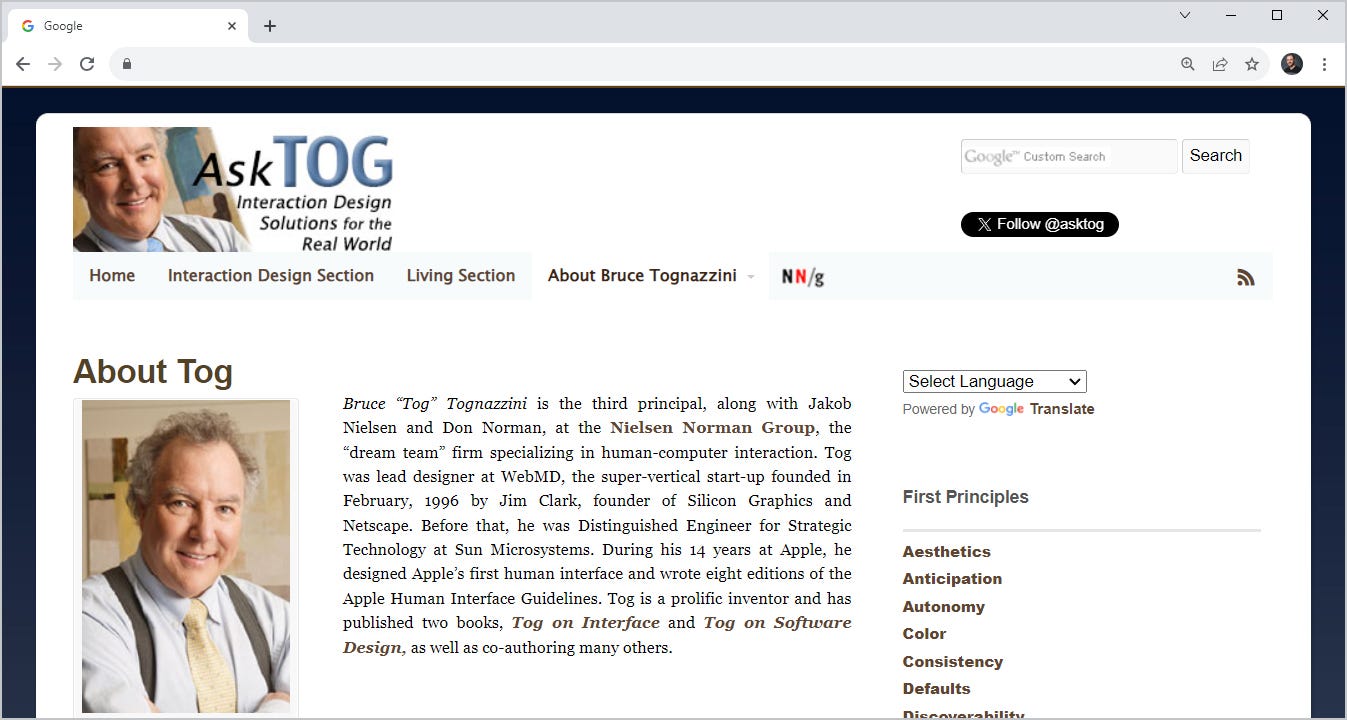Beyond Heuristics: Embracing Tog's First Principles of Interaction Design
Expanding UX Best Practices with Tognazzini's Timeless Framework
Summary: Reintroducing Bruce Tognazzini's First Principles of Interaction Design to expand our understanding of UX best practices.
On this blog, I frequently reference Jakob Nielsen's 10 usability heuristics as an excellent starting point for understanding UX best practices. I use these as a shorthand when talking about foundational UX understandings. Recently, a subscriber suggested that my reliance on these heuristics might lead to overlooking other fundamental UX principles. Even though I mostly talk about the 10 heuristics here, I often incorporate other frameworks in my day-to-day work. In this article, I'd like to introduce everyone to one of those other frameworks: Bruce 'Tog' Tognazzini's First Principles of Interaction Design. For years, I've combined these principles with the 10 usability heuristics, deepening my understanding of usability basics.
"I especially lean on Tog's principles when thinking through complex interaction within complex UIs."
I hope sharing this will inspire some of you to revisit this oldie-but-goodie gem from the HCI repositories of the past. Everything here is as relevant today as it was back when it was initially published and is a great resource for advanced UX professionals.
About Bruce Tognazzini
Before we look at Bruce Tognazzini's First Principles of Interaction Design, I'd like to give you a little context about who he is and why we should respect his perspective. Bruce "Tog" Tognazzini is a principal at the Nielsen Norman Group alongside Jakob Nielsen and Don Norman. He is widely considered a trailblazer in human-computer interaction. Tog's impressive career spans roles at Apple, where he developed their first human interface and authored the Human Interface Guidelines, to lead designer at WebMD, and Distinguished Engineer at Sun Microsystems.

Tog holds 57 patents across various domains, including the significant electronic viewfinders in digital cameras and the Rolling Blackout Password Entry System. As a consultant, speaker, and author, he has influenced a wide range of industries, sharing his expertise globally. His books, "Tog on Interface" and "Tog on Software Design," along with his involvement in high-profile legal cases, underscore his deep understanding of UX design and its impact on technology and interaction. Read Tog's full bio here.
Tog's First Principles of Interaction Design
Tog's framework offers a thorough guide for optimizing complex software and web interface designs. It encompasses a variety of key concepts essential for creating high-quality user experiences. It comprises 23 areas of focus, each with its own set of principles.
📓 NOTE: Before reading my half-baked summary of these areas of focus, please consider reading the full article instead. Reading these things in Tog's own words is much better than reading my summary below.

TL;DR: The First Principles of Interaction Design Summarized
Aesthetics: The visual appeal of a design is crucial for user engagement and perception. Good aesthetics enhance usability by making interfaces attractive and enjoyable to use.
Anticipation: Designing interfaces that predict and fulfill user needs before they arise. It involves understanding user behavior to preemptively provide relevant information or actions.
Autonomy: Allowing users control and flexibility in their interactions. Autonomy in design means enabling users to customize their experience or choose different paths to achieve their goals.
Color Blindness: Ensuring accessibility for users with color vision deficiencies. This includes using colors that are distinguishable by color-blind users and not relying solely on color to convey important information.
Color as a Vital Interface Element: Utilizing color effectively to enhance usability and convey meaning. Colors can differentiate elements, indicate status, and guide user attention.
Levels of Consistency: Maintaining uniformity across various aspects of the interface, such as design elements, behaviors, and language, to create a coherent and predictable experience.
Induced Inconsistency: Deliberately introducing inconsistency to draw attention or signify importance. It's used sparingly to highlight key areas or changes in the interface.
Continuity: Designing seamless transitions and preserving user context throughout the experience. It helps users maintain their flow of work or thought across different parts of the system.
Consistency with User Expectation: Aligning the design with user expectations based on their prior experiences and industry standards. It helps users feel comfortable and quickly adapt to the interface.
Defaults: Providing sensible and helpful default settings to streamline user experience and reduce the effort required for common tasks.
Discoverability: Making features and functionalities easily discoverable. Good design ensures that users can find what they need without confusion or extensive searching.
Efficiency of the User: Designing for optimal user efficiency by minimizing the effort and time required to complete tasks and by offering shortcuts for experienced users.
Explorable Interfaces: Creating interfaces that encourage exploration without risk of error or data loss. This approach allows users to learn by doing, reducing anxiety in interacting with the system.
Fitts's Law: Designing with the principle that the time required to move to a target is a function of the target size and distance. Larger, closer targets are faster to navigate.
Human Interface Objects: Ensuring that objects in the UI behave predictably and understandably based on real-world analogies and user expectations.
Latency Reduction: Minimizing the delay between user actions and system responses to enhance the user experience and maintain flow.
Learnability: Making interfaces easy to learn and understand so new users can quickly become proficient.
Use of Metaphors: Employing familiar metaphors to make interfaces intuitive and easier to navigate by relating digital elements to real-world objects and concepts.
Protect Users' Work: Preventing loss of user data and work through features like auto-save, easy undo actions, and explicit warnings about potential data loss.
Readability: Ensuring that text is legible and easy to read through appropriate font choices, sizing, contrast, and spacing.
Simplicity: Striving for simplicity in design to make interfaces more approachable, understandable, and less overwhelming.
State: Accurately reflecting the system's state and any changes to it, helping users understand the current context of their interactions.
Visible Navigation: Designing navigation elements to be clearly visible and understandable, guiding users smoothly through the interface.
These ideas are time-tested and have worked well for me throughout my career. This list, paired with the 10 usability heuristics, provides a deep understanding of UX best practices when offering secondary research guidance to UX teammates.
Conclusion
By integrating Tog's principles into my work, I've been able to approach UX research with a more well-rounded perspective, ensuring that the solutions I propose are deeply rooted in proven UX methodologies. Frequently revisiting and relearning these foundational principles is crucial for all of us doing UX in the real world to stay sharp and grounded. Whether you're just starting out in UX or are a seasoned professional, I encourage you to explore these principles in your own work and see how they can enhance your approach to creating exceptional user experiences.
What do you think of Tog's First Principles of Interaction Design? Were you aware of these before reading this article? If so, how do you use them to be a better UX researcher? Comment below or DM me to continue the conversation.




